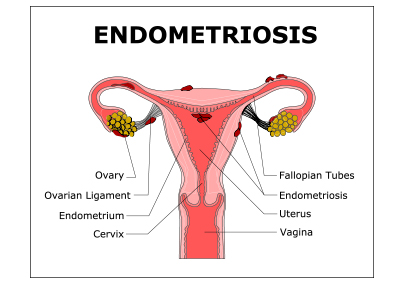What Is Endometriosis?
Endometriosis is a disorder in which tissue that normally lines the uterus grows outside of the uterine cavity on other pelvic organs. Endometriosis tissue is often found near the ovaries (where eggs are made), fallopian tubes (tubes that carry eggs to the uterus), on the peritoneum (the inside lining of the abdomen or belly), or on other organs.
 What Causes Endometriosis?
What Causes Endometriosis?
There can be many causes, but the most common is retrograde menstruation. Normally when a woman has her period the blood flows out of the uterus through the cervix and out the vagina. With retrograde menstruation, the blood flows backwards causing cells on the inside of the uterus to flow out of the fallopian tubes and spill into the cavity of the pelvis and abdomen. This can seed the surrounding structures of the uterus with tissue that is not supposed to be there.
What Are the Symptoms of Endometriosis?
Endometriosis can be associated with the inability to get pregnant, abnormal bleeding, and pelvic pain. It can also show up as a type of cyst on the ovary called an endometrioma or “chocolate cyst.” Symptoms may include:
- Pain in the lower abdomen, lower back, pelvis, rectum, and/or vagina
- Pain during sexual intercourse or while defecating
- Abnormal, heavy, irregular, and/or painful menstruation; spotting
- Constipation
- Nausea
- Abdominal fullness or cramping
- Infertility
What Are the Treatment Options for Endometriosis?
Endometriosis can be treated both medically and surgically.
Depending on the specifics of each patient’s case, surgical treatment of endometriosis may include:
- Removing or burning endometriosis (excision or ablation)
- Ovarian cystectomy (removal of endometrioma cyst)
- Removal of endometriosis deep within the reproductive organs (deep infiltrating endometriosis)
- Removal of uterus with or without ovaries
What Minimally Invasive Options are Available?
Laparoscopic surgery is a minimally invasive treatment offered at Erlanger for many patients. With this procedure, the surgeon performs an examination (biopsy) and removes the suspected tissue. This is done through small incisions in the abdomen under general anesthesia, with the abdomen temporarily expanded through use of gas. The surgeon then uses a camera or laparoscope to look directly at the pelvis and use special instruments to remove any endometriosis tissue.
This is called minimally invasive surgery because the small incisions are less damaging for women's bodies. Women who have laparoscopic or robotic surgery recover more quickly, have less pain, and have fewer infections than women who undergo traditional abdominal surgery with a large incision.

